Chlorophyll | The green blood – Part 2
 Hello again! After we explained in such detail why chlorophyll is incredibly good for us in part 1 of this article on chlorophyll, we know that green is simply in our nature and is of enormous importance for our health.
Hello again! After we explained in such detail why chlorophyll is incredibly good for us in part 1 of this article on chlorophyll, we know that green is simply in our nature and is of enormous importance for our health.
In addition to chlorophyll, greens often contain a wealth of other substances that fill us with strength and health.
They are the most natural foods and superfoods and are not bred as much as fruit and, unfortunately, vegetables may be.
How do I integrate chlorophyll into my everyday life?
Anyone who has made this resolution will probably not be able to avoid a healthier diet.
It is important to include leafy greens in your diet: Nature’s best offerings are wild herbs.
Take what you can get and incorporate it into a salad.
The most common are stinging nettles, dandelions, sorrel and many more.
The supermarket also has a lot to offer that can cover your chlorophyll needs: Parsley and other herbs, kale, spinach, broccoli, green beans and peas. Of course, sprouts are also always a good idea. But the “chlorophyll giants” were these…
Spirulina
Spirulina is often referred to as blue-green algae or microalgae, but is actually a cyanobacterium and originally comes from tropical and subtropical regions.
Some sources report that this type of algae was cultivated by the Aztecs in Central America over a thousand years ago as a source of nutrients.
The indigenous people, the Kanembu around Lake Chad, also cultivated algae in this way. What’s inside? At that time, of course, the composition of the algae was not yet known, which makes it all the more interesting today: spirulina has a very high protein content (70-80%) with a high biological value, as it contains all the essential amino acids. In addition, the spirulina membrane dissolves well in stomach acid, which makes it easy to digest.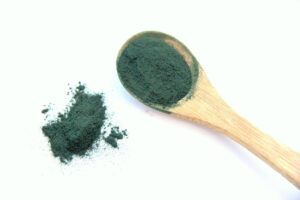 The algae also has a particularly high density of essential fatty acids with a high proportion of alpha-linolenic acid (ALA) and gamma-linolenic acid (GLA).
The algae also has a particularly high density of essential fatty acids with a high proportion of alpha-linolenic acid (ALA) and gamma-linolenic acid (GLA).
GLA is only found in borage, evening primrose and blackcurrant oil as well as in breast milk and spirulina.
The subclass of dihomo-gamma-linolenic acid (DGLA), on the other hand, is only found in spirulina and breast milk.
Spirulina also contains valuable pigments: First and foremost phycocyanin, up to 70 mg of the substance is contained in a single cyanobacteria.
The popular blue spirulina powder is extracted from this pigment and is therefore quite cost-intensive.
Phycocyanin is a powerful antioxidant and protein.
Spirulina also contains 25 times more β-carotene than the well-known carrots.
Beta-carotenoids also have antioxidant activities and, like phycocyanin, protect the body from free radicals, which are the main cause of ageing and degeneration. Another valuable pigment is chlorophyll, which gives color – you can look up its mode of action in detail here.spirulina contains around 1500 mg of chlorophyll per 100 g .
So if you take 5 g of spirulina a day, that’s 75 mg of chlorophyll from this small amount alone. And the rest? Thanks to its enormous range of minerals and vitamins, spirulina can help to strengthen the liver and kidney cells and also render toxins harmless in the circulatory system, making the algae ideal for detoxification cures that put a strain on the kidneys and liver.
Chlorella
Chlorella algae is the largest of the “chlorophyll giants”, as chlorophyll makes up around 3% of the dry mass of the algae – making this small algae the food with the highest chlorophyll content on earth. 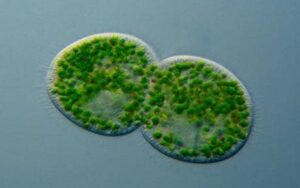 Unlike spirulina, chlorella algae is actually an algae and not a bacterium.
Unlike spirulina, chlorella algae is actually an algae and not a bacterium.
It consists of many microscopically small and very complex single-celled organisms which, due to their complexity, are highly developed living beings.
They have been living on our planet for more than two million years and have defied all changes in their living conditions and all other adversities since then, thus proving their amazing powers. Why does chlorella detoxify so well? However, the first scientific description of Chlorella Vulgaris was not made until 1889.
Melvin Calvin used it to research photosynthesis and was awarded the Nobel Prize for his work in 1961.
After being discovered so late, the algae has gained popularity to this day – today it is considered a chi tonic in China and is used for many health problems, as it has been recognized that it detoxifies and (thanks to chlorophyll) strengthens vitality.
In “alternative medicine“, chlorella is used even more frequently than spirulina for detoxification and especially for heavy metal elimination and amalgam removal.
This is partly due to the high chlorophyll concentration, as the unsurpassed quantities are of immense importance for the liver, as they protect the liver cells from countless toxins that enter the body on a daily basis. The algae also contains other detoxifying and cell-protecting substances: some carotenoids (e.g. lycopene), glycoproteins (CGF and CVE), glutathione – a sulphur-containing protein, sporopollein – a strongly detoxifying component of the robust chlorella cell wall and many detoxifying dietary fibres.
The dietary fibers are not digested and therefore provide valuable services to the intestines.
They ensure regular bowel movements. Toxins and other disease-causing substances also form inseparable bonds with the dietary fibers on their journey so that they can be excreted together. So whether it is carcinogenic substances such as heavy metals and radioactive substances, toxins from fungi or chemical residues, poisons such as arsenic, molds, pesticides or other environmental toxins that we are confronted with – and this is really not a rarity today, but rather the rule – they are all quickly excreted from the intestine with chlorella. So it’s no wonder that chlorella is known for its powerful detoxifying effect.
And this is precisely why caution is advised, because it can also be dangerous for people who have a high toxic load. That’s why it’s always good to start slowly and listen to your body. There are people who react to just one chlorella tab and others do not notice any side effects even after 300.
Barley grass
Barley grass, a simple little grass.
A modest, long, thin stalk grows from a small grain of barley.
At first glance, the small plant appears so simple and inconspicuous.
And yet appearances are deceptive, because a very special plant is hiding behind it…
Dr. Yoshihide Hagiwara is considered the discoverer of barley grass. As a pharmacist and developer of pharmaceutical drugs, his hair and even some of his teeth fell out when he was 30 years old.
Apparently fed up with this, he began his research with the aim of restoring his own health. He compared 200 different leafy vegetables with each other and discovered that barley grass contained more minerals, more trace elements, more vitamins, more bioflavonoids and more enzymes than all the other green plants analyzed.
He also compared barley grass with conventional foods.
The tests revealed, for example Barley grass contains …
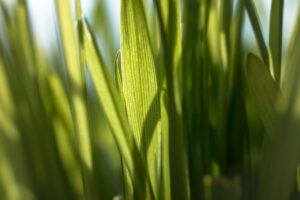
- 11 times as much calcium as cow’s milk
- 5 times as much iron as spinach and broccoli
- 4 times as much vitamin B1 as whole grain (wheat)
- 7 times as much vitamin C as oranges and
- as much zinc as the richest sources of zinc of animal origin
The leaves of the young barley plant have the most balanced nutrient concentration of all the plants examined.
Gently spray-dried, barley grass (juice) powder dissolves easily in water and has a pleasantly sweet taste.
Barley grass has been cultivated for grain production for over 5000 years.
Even then it must have been used as a green plant.
It is reported that the Babylonian ruler Nebuchadnezzar (605-562 BC) fed exclusively on barley grass for seven years during his exile in order to achieve health and mental clarity – he was a little earlier than the pharmacist…
What gives this simple plant so much power? The chlorophyll has a particularly positive effect on the renewal of blood cells with the enzymes of the sweet grass . And who would have thought it, barley grass is also a true master of detoxification in its own way . And then there’s lunasin, which has been shown in some studies to have positive effects on various types of cancer.
Barley grass can therefore be part of a generally healthy lifestyle and can also be incorporated into an anti-cancer diet.
The abundance of antioxidants, including rare ones such as saponarin, lutonarin and six others, make the grass powerful – among the antioxidants is an enzyme called superoxide dismutase (SOD), which has so far only been found in barley grass.
It is said to be able to protect against radiation damage and carcinogenic substances. Barley grass and blood sugar Barley grass is also very interesting for diabetics: A clinical study was published in the International Journal of Green Pharmacy in 2010.
Diabetics were given just 1.2 g of barley grass a day for two months and there was a significant reduction in blood sugar and cholesterol levels. And that with such a small amount and without any other measures! Taiwanese scientists have also found that barley grass combined with vitamin-rich fruits, vitamin E-rich nuts and vegetable oilsin a green smoothie can lower cholesterol levels! Blood circulation, oxygen supply and blood pressure can also improve. Beneficial for the gut The intestines are happy about the high fiber content.
They support digestive activity and can have a soothing effect on flatulence, constipation and other intestinal disorders.
People who suffer from intestinal problems in particular have a problem with the supply of nutrients, as intestinal absorption no longer works well and benefit twice over from the extra supply of barley grass.
A study from Japan showed incredible success with barley grass in ulcerative colitis, an inflammatory bowel disease associated with diarrhea, vomiting and abdominal pain.
The study was quite small, only 18 patients were tested, but this barley grass group, in contrast to the group treated with the usual anti-inflammatory drugs, showed a significant improvement in symptoms after just one month.
They were given 30g of barley grass daily and this improved their intestinal flora, so that they had less pain and diarrhea. This is because when the intestinal environment is healthy, harmful bacteria cannot survive, toxins are reduced, the tendency to inflammation decreases and symptoms recede. In addition, barley grass reduces an inflammatory factor that is partly responsible for ulcerative colitis (epithelial NF-k) and the water content of the stool is reduced, which improves diarrhea and reduces the risk of colon cancer.
Candida fungal infections and lack of motivation can also improve as a result.
If the intestines are healthy, we feel more agile and vital – barley grass ensures a good mood, less stress and sleep disorders and can even help with attention deficit. It dissolves
calcium deposits in joints and thus helps with the Maintaining a healthy bone structure.
Moringa
And finally, there is Moringa Oleifera. Originally from the southern Himalayan region in northern India, this tree is also known as the“tree of life”.
It grows an incredible 30 centimetres a month and is considered to be the fastest growing tree of all, growing up to 8 meters in its first year and its wood is therefore used as a rapidly renewable source of energy.
The “tree of life” can withstand droughts and is used in Ayurvedic medicine, the traditional Indian medicine. Its bark, roots, leaves, seeds, flowers and fruits were mainly processed into juices, teas and oils and used for a wide variety of indications.
Pharmaceutical preparations made from the leaves of the moringa tree are said to have been used to prevent more than 300 diseases.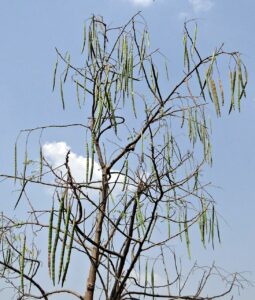 The seed of the miracle tree Another interesting fact is that its seeds are used to purify water. This is because the seeds are able to – get this – purify water. purify and disinfect water, i.e. kill germs.
The seed of the miracle tree Another interesting fact is that its seeds are used to purify water. This is because the seeds are able to – get this – purify water. purify and disinfect water, i.e. kill germs.
Researchers have found that 2 pieces of moringa seeds are able to purify one liter of polluted pond water both bacterially and from various types of germs. to clean suspended matter and to clean.
In the process, a certain protein from the seeds to impurities in the water, causing them to aggregate, so that the resulting clusters are removed from the water. can be separated. The University of Stuttgart researched this amazing property of the seeds 20 years ago and discovered that the more turbid the water, the greater the sterilizing effect. This makes Moringa projects in Africa even more interesting.
It should not be forgotten that the human body also consists of a very high proportion of water.
Conversely, this means that the regular consumption of Moringa products cleanses and detoxifies the human body accordingly.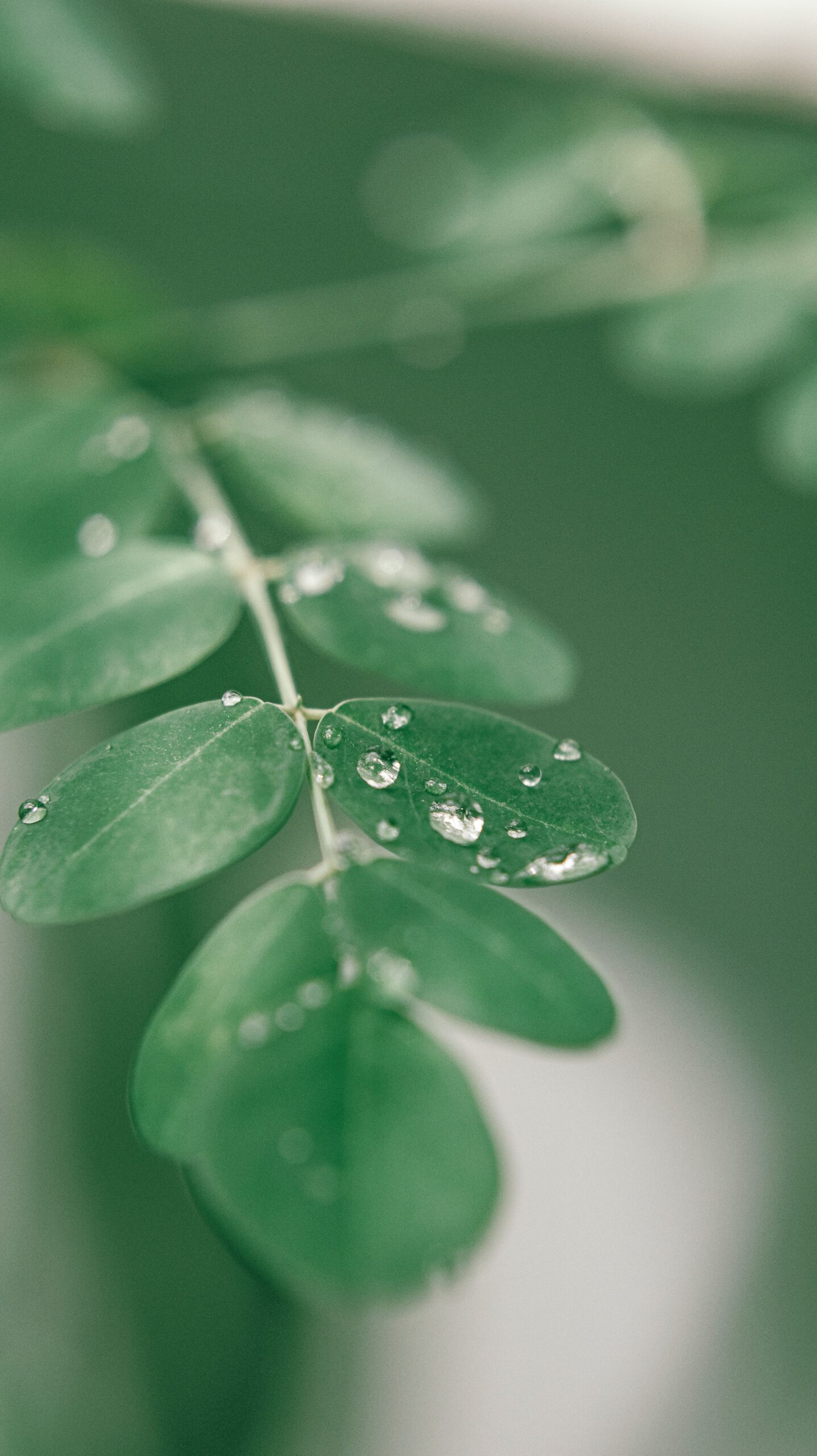 Amazing leafy green Of course, the leaves of the tree are not without their benefits either, they are a “survival food” with 90 nutrients: all twenty amino acids, minerals such as calcium and potassium in particular, trace elements such as copper and iron in particular as well as B vitamins, vitamins A, C, D, E and K and, of course, we find a concentrated load of chlorophyll among them.
Amazing leafy green Of course, the leaves of the tree are not without their benefits either, they are a “survival food” with 90 nutrients: all twenty amino acids, minerals such as calcium and potassium in particular, trace elements such as copper and iron in particular as well as B vitamins, vitamins A, C, D, E and K and, of course, we find a concentrated load of chlorophyll among them.
It is also rich in iron and manganese, making it particularly good for treating anemia. The combination of the blood-like chlorophyll and iron is unbeatable.
In addition, manganese is converted into iron in the body, which is why iron deficiency inevitably leads to manganese deficiency over time. The leaves are rich in antioxidants and contain the rare zeatin and the antioxidants lutein and zeaxanthin, which are important for eyesight.
Their antioxidant potential is not so noticeable in direct comparison with other plants, but stands out in combination with the other ingredients. Comparable to the antioxidants in broccoli (sulforaphane), which they closely resemble, moringa antioxidants are likely to initiate genetic processes at cell level. It is the aforementioned zeatin, the tree’s growth hormone .
Zeatin kommt in keiner anderen Pflanze in so hohem Maße vor. Moringa contains a hundred times more zeatin than other plants – one microgram per gram!
It is already used in agriculture to increase the growth and yield of plants and is also used in some anti-ageing creams.
It is a powerful antioxidant and promotes the beauty and health of the skin, accelerates skin regeneration and slows down skin ageing.
The moringa leaf can therefore be used to treat skin damage and rejuvenate the skin.
But zeatin can do even more.
It is a plant hormone that helps to balance hormone levels, especially during puberty and menopause.
Zeatin also serves the body as a“sluice“, as it helps with the absorption of other vital substances. Bor ey, that’s awesome! As green as the superfood is, the detoxification function is not missing here either.
The plant contains high amounts of boron. Boron competes with the environmental toxin aluminum.
This means that due to a lack of boron, aluminum can easily occupy the places in the brain intended for boron.
However, boron should be the most common trace element in the body!
This is because boron is important for the flow of energy in the body, and boron can be lacking in cases of congestion, cramps or epilepsy.
Boron also helps the body to store calcium in bones and teeth, making bones harderand helping fractures to heal more quickly.
Boron also means that 40 percent less calcium and magnesium are excreted via the kidneys and remain in the body, and moringa is also rich in calcium.
Boron has an effect on depression, hyperthyroidism and brain function when taken in the right amounts.
The chlorophyll drop trend and why nature is incorrigible
These were our top 4 chlorophyll hits.
These plants have incredible potential. 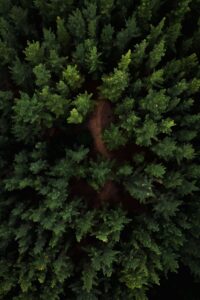 Maybe you’ve already found out which plant could be good for you while reading?
Maybe you’ve already found out which plant could be good for you while reading?
Because every plant is unique.
There has been a trend on the health market for some time now. Chlorophyll drops, the concentrated power of chlorophyll in a small bottle – at least that’s the theory.
So why not simply take chlorophyll in its pure form?
Extracted chlorophyll is certainly also effective and in no way harmful! However, our recommendation is clearly to stick close to nature. In addition to chlorophyll, each plant also has its own special features and benefits. Plants always work synergistically, i.e. their ingredients complement each other so perfectly that their overall effect is potentiated (e.g. the iron, manganese and chlorophyll in moringa leaf green).
This is why the effect of a single ingredient is never as great as the combined effect of all the components. Nature means well with us, extracts such as phycocyanin (blue powder from spirulina) are a nice idea, e.g. for a blue coloring in food and certainly not unhealthy – but spirulina, as nature provides it to us, has a much stronger effect on our health and is also cheaper.
Our recommendations
As the chlorophyll giants are so effective, you will of course find them in our store.
1. spirulina: Here you can go directly to our spirulina from Akalfood, either from Germany or Soli Spirulina from Africa.
Spirulina from Akalfood is dried gently and at below 42°C, so the drying process takes a little longer than with other companies.
This means that all the nutrients are retained and the typical mild, crunchy taste of raw spirulina is retained.
Naturally, spirulina is free from harmful substances. 2. chlorella: Our chlorella algae from Algomed are also tested for harmful substances and are free of them.
This and the organic quality are guaranteed in any case, as the algae are grown in a glass tube system filled with mountain spring water in Germany.
This is an exceptional quality feature, especially for algae products, as many low-cost suppliers source their algae from farms, usually in China, which are not protected and can be contaminated by environmental toxins in the air.
Unfortunately, these algae then have the opposite effect on the body in the worst case. 3. barley grass: Barley grass is available from us in the form of organic barley grass juice powder from Landkaufhaus Mayer. Barley grass juice powder has several advantages over barley grass powder. This is spray-dried juice from the grass.
Grass powder is simply dried, shredded grass, which is actually hay.
However, the human stomach is not designed to break down the plant cellulose in grass. When ingested, many nutrients remain in the grass which are trapped in the cellulose and are excreted again.
Grass juice powder is different, as only the pure essence of the grass is used and dried, without the cellulose.
This allows our body to access the nutrients it contains very easily and utilize them much more effectively.
As a result, the grass juice powder is also easy to digest and does not place an additional burden on the digestive tract. 4. moringa: We have moringa leaf powder and moringa seeds from wild growth.
Both come from Africa and are produced by Labite Agnitevi from Togo.
He has been trained by his families of healers to use nature with its infinite treasures of to regard medicinal plants as a gift to mankind and to use them.
With his sustainable, fair and ecological products socialand educational projects . He mainly supports the school that his mother (a healer) built in Lomé, Togo.
She also manages and controls the production of his Natural products.
Green, green, green is all I have
– and what I need.
I hope I was able to bring you a little closer to green. With this in mind, I wish you a green and healthy start to December!
Feel free to post any questions, answers and suggestions in the comments.
🙂 Until then.
Sources:
- The wonderful series of publications from Nature and Therapy on the subject of moringa and boron
- Center of Health Center
- The Heilpraktikerverband
- Book: Chlorophyll – Health is green, Peter Carl Simons
- Information from the manufacturer
